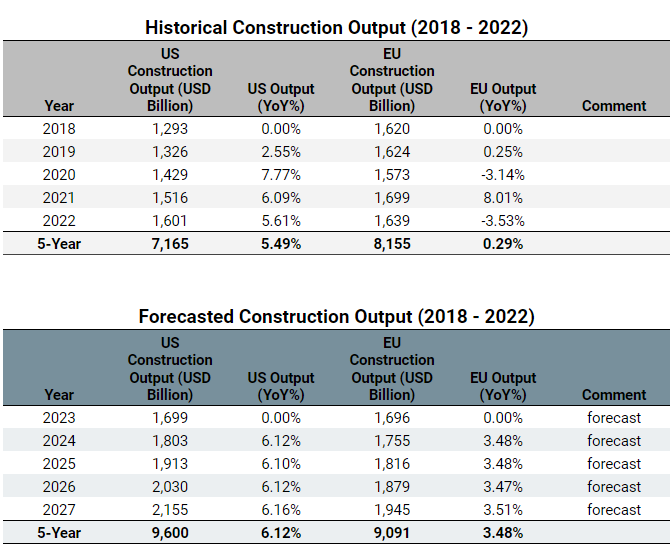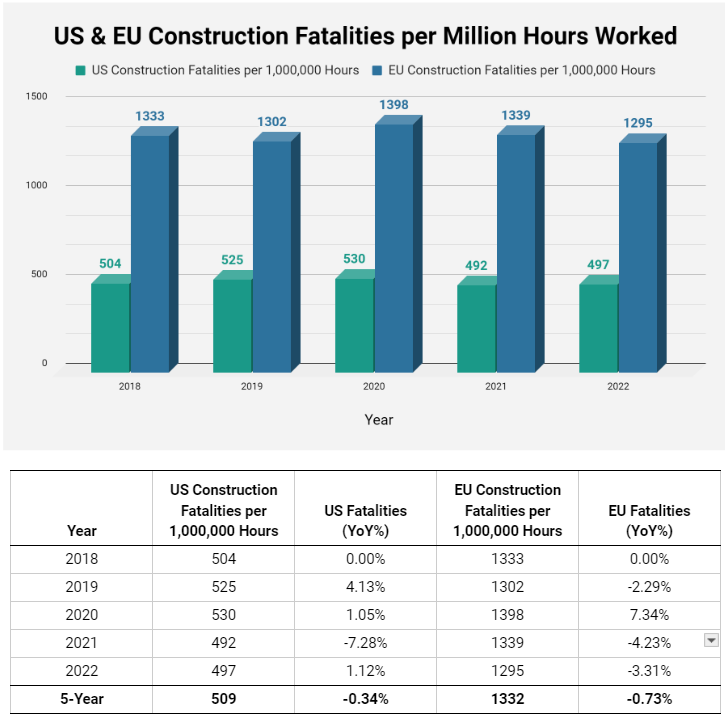Construction Safety Headwinds in the U.S. and Europe
A comparison of the United States and Europe and their respective strategies to address labor shortages and construction safety.
Purpose
The purpose of this article is to compare and contrast construction demands in the United States and Europe as well as how each is addressing labor shortages and the corresponding safety challenges facing the industry.
Overview
Both the United States and Europe are experiencing significant growth in construction, driven by increased infrastructure, sustainability, and data center investments. While the EU market is larger in absolute terms, the US is catching up with robust growth across the sector, expecting to surpass the EU in total output by 2027.

Summary of Construction Output Trends
United States
- Historical Growth: The US construction industry has seen steady growth over the past five years, with total output increasing from USD 1,293 billion in 2018 to USD 1,601 billion in 2022.
- Forecasted Growth: The industry is expected to continue growing at an annual rate of 6.1%, reaching approximately USD 2,155 billion by 2027. This growth is driven by substantial investments in infrastructure and residential construction.
Europe
- Historical Growth: Europe's construction output has fluctuated over the past five years, peaking at USD 1,699 billion in 2021 before declining slightly to USD 1,639 billion in 2022.
- Forecasted Growth: The European construction industry is projected to grow at an annual rate of 3.5%, reaching around USD 1,945 billion by 2027. This growth is supported by significant investments in transportation and energy infrastructure.
Key Factors Driving Growth
- Technological Advancements: Both regions are leveraging advancements in construction technology, such as automation, robotics, and Building Information Modeling (BIM), to enhance productivity and efficiency.
- Sustainability Initiatives: There is a growing emphasis on sustainable construction practices, with increased use of eco-friendly materials and energy-efficient designs.
- Skilled Labor Shortages: Addressing the skilled labor shortage is crucial for both markets. Strategies include enhanced training programs, the adoption of new construction methods, and the use of advanced technologies to mitigate labor constraints.
Latest Trends in Construction Labor
Labor Shortages and Workforce Management
- The persistent challenge of labor shortages requires innovative solutions. Prominent industry players are increasingly turning to artificial intelligence (AI) tools and automation to streamline operations, especially for repetitive or labor-intensive tasks. Strategic recruitment practices and employee retention are crucial to bridging this gap.
Technological Advancements
- Advances in AI, robotics, and automation are transforming the construction sector. Drones and unmanned aerial vehicles (UAVs) are now integral for site surveys and inspections, significantly improving efficiency and safety. Building Information Modeling (BIM) continues to revolutionize project management by enhancing coordination and reducing errors.
Sustainability and Green Construction
- Sustainability is becoming a vital component of construction practices. The industry is adopting eco-friendly materials and energy-efficient technologies to reduce environmental impact. This includes the use of living building materials, which can self-replicate and absorb CO2 during production, contributing to climate goals.
Prefabrication and Modular Construction
- The use of prefabricated materials and modular construction techniques is growing. These methods save time, reduce waste, and improve construction efficiency. They are particularly beneficial in addressing labor shortages by reducing on-site labor requirements.
A Comparison of Worker Safety Across All Construction Activity
While Europe has a significantly higher rate of fatalities per hour worked overall, both regions have been successful over the last 5 years at holding fatality rates nearly constant in spite of rising construction output. However, the “safety stakes” in the United States may be higher due to a higher forecasted growth rate in overall construction.

Enhancing Construction Worker Safety: A Critical Imperative
As construction output surges, the demand for skilled construction workers rises concurrently. Advances in construction strategies and technologies have increased output per hour worked, but these improvements alone cannot fully offset the growing need for labor. Striving to achieve more with the same or fewer workers can only go so far before compromising safety. Therefore, enhancing construction worker safety has never been more crucial.
The Imperative of Safety
- The criticality of robust safety measures in construction cannot be overstated. A strong focus on safety is essential not only for protecting workers but also for maintaining high standards of quality and ensuring timely project completion. The culture within a construction firm plays a pivotal role in shaping its safety protocols. A positive and proactive safety culture can significantly reduce the risk of accidents and injuries, promoting a safer and more efficient work environment.
The Role of Culture
- A company’s culture directly influences its approach to safety. Firms that prioritize safety create an environment where workers feel valued and protected, which in turn fosters greater attention to detail and adherence to safety practices. This culture of safety leads to higher quality work and reduces delays caused by accidents or unsafe practices.
Mentoring and Training
- Mentoring and training are essential components of a strong safety culture. Continuous education ensures that workers are up to date with the latest safety standards and practices. Mentoring programs help instill a sense of responsibility and commitment to safety among employees, reinforcing the importance of following safety protocols.
Enhanced Worker Safety
- Advancements in safety technology, such as virtual reality (VR), wearable devices, and AI-driven predictive hazard analysis, are significantly reducing workplace accidents. These innovations offer real-time monitoring and immersive training experiences, making construction sites safer.
Conclusion
As the construction industry continues to grow, the imperative to enhance worker safety becomes increasingly critical. A robust safety culture, supported by effective mentoring and training programs, is vital for protecting workers, maintaining quality, and ensuring timely project delivery. Emphasizing safety is not just a regulatory requirement; it is a fundamental aspect of a successful and sustainable construction industry.
By prioritizing safety, the industry can achieve its growth objectives while safeguarding the well-being of its workforce, ultimately leading to more resilient and reliable infrastructure.
Cited Sources
- Bureau of Labor Statistics (BLS)
- Bureau of Labor Statistics
- Associated Builders and Contractors (ABC)
- ABC
- JLL Research on Data Centers
- JLL Research
- Technavio Report on Data Center Market in Europe
- Technavio
- Gartner Research on Data Center Sites
- Gartner
- Eurostat
- Eurostat
- European Agency for Safety and Health at Work (EU-OSHA)
- EU-OSHA
- CPWR Construction Fatality Map Dashboard
- CPWR
- Global Construction Review
- Global Construction Review
- Occupational Safety and Health Administration (OSHA)
- OSHA
- Centers for Disease Control and Prevention (CDC) - NIOSH
- CDC - NIOSH
- BigRentz - Construction Industry Trends
- BigRentz
- EURACTIV
- EURACTIV


